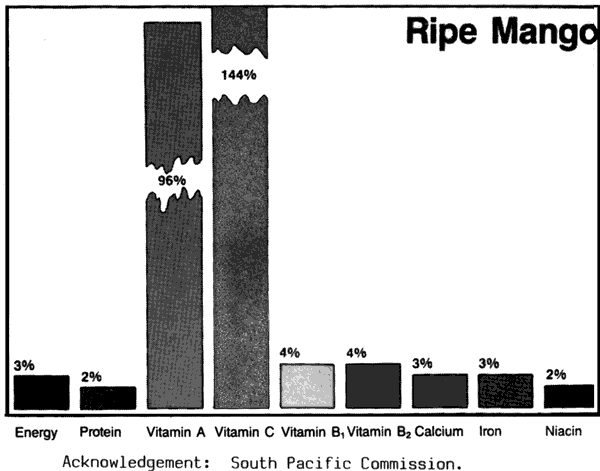
MANGO - A FRUIT FOR THE FAMILY
SCIENTIFIC NAME: Mangifera indica
FAMILY: Anacardiaceae
On many Pacific islands where it grows wild, the mango tree seems to belong to the children. Even before the mangos are ripe, children can be seen high in the tall mango trees picking and eating their favourite fruit. But mangos are a fruit for adults as well as children. The whole family can enjoy fresh juicy mangos picked from the tree or bought at the market whenever they are in season. This nutritious fruit is healthier, tastier and cheaper than sweets bought at the store. Mangos can be eaten plain, or included in some recipes. Whatever way they are used, mangos add good nutrition and flavour to family meals.
TALL TREES AND TASTY FRUITS
The mango tree has the scientific name of Mangifera indica. It grows to 15-18 metres (50 to 60 feet), tall and is thickly covered with narrow, dark green leaves. Mango trees begin bearing fruit when they have been growing for about six years from a seedling. The fruit usually ripens during the summer rainy season. Sometimes trees will have heavy crops every other year, bearing much fruit one year and little the next. After a tree is about forty years old, it bears less fruit each year.
Many kinds of mango fruit are found in the Pacific. They are different sizes, shapes and weights. They can be green, yellow, orange, red or a mixture of colours. The best mangos are smooth and juicy with their own special flavour, but the many kinds all taste and feel different. It is difficult to make rules about which type of mango to use, because some kinds of mangos grow on some islands and not on others. Local experience and experiments can help decide which mangos are best in which recipes.
A NUTRITIOUS TREAT
Ripe mangos are an excellent source of Vitamin A, which is needed for proper growth, healthy eyes and protection from disease. Green mangos contain smaller amounts of Vitamin A. Mangos are high in Vitamin C as well. Vitamin C keeps the body tissues strong, helps the body to use iron, and aids in chemical actions in the body. The amount of Vitamin C is different in different kinds of mangos, but a green mango usually has more than a ripe one. Children who eat green mangos will get a lot of Vitamin C, but because green mangos are hard to digest, they may also get upset stomachs.
A FOOD FOR BABIES
Because it is soft and full of vitamins, mango is an excellent food for babies. Babies need to be given soft foods when they are 4 to 6 months old as well as breast milk. Mango juice or mashed ripe mango makes a good first food for babies. Mashed mango must first be strained so that the stringy part of the mango does not choke the baby.
A VARIETY OF USES
Mangos are best when picked ripe from the tree, but mangos picked when still green will continue to ripen if they are kept in a cool dry place. Once mangos are fully ripe they must be eaten straight away or kept in a refrigerator. Eating mangos raw is the most nutritious way to eat them. Ripe mangos are good for breakfast, for dessert, or as a treat between meals. They may be flavoured with lemon or lime juice or mixed with other fruits.
Mangos may also be cooked. They can be used in almost any recipe requiring a sweet fruit. But, because different kinds of fruit contain different amounts of water, the amount of water or other liquid required in a recipe may have to be changed.
Since mangos are not easy to get all year round, they can be preserved by drying them. Dried mangos are an excellent treat for children and are healthier than lollies, sweets or ice cream.

DATE: November 1986
* * * * * * * * * * * * *
